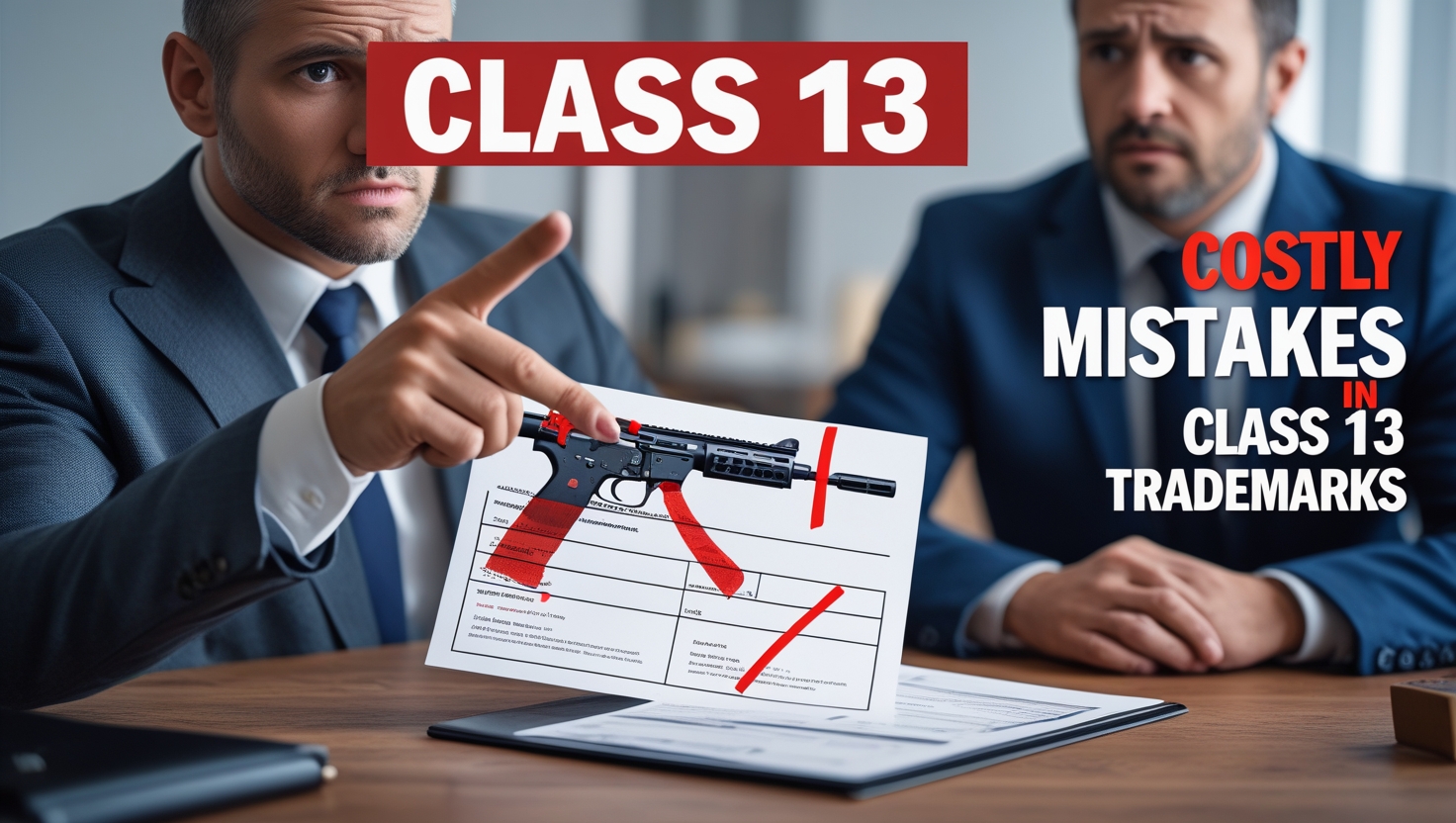In the highly regulated and competitive firearms and ammunition industry, protecting your brand is critical. Registering a trademark under Class 13 is the key step for firearm and defense equipment brands to safeguard their identity and build trust with customers. However, many brands make avoidable errors during the trademark registration process that can cause delays, rejections, or legal complications.
This blog explores the most common trademark mistakes firearm brands make under Class 13 and provides practical advice on how to avoid them. Whether you’re a firearm manufacturer, ammunition supplier, or a retailer, understanding these pitfalls can help you successfully register your trademark and secure your brand’s future.
What is Trademark Class 13?
Before diving into the mistakes, a quick overview: Trademark Class 13 covers firearms, ammunition, explosives, and related equipment. It includes guns, rifles, bullets, cartridges, grenades, and even firearm accessories.
Brands operating in this space must register their trademarks under Class 13 to protect their logos, brand names, and other distinctive marks associated with their products.
1. Not Conducting a Comprehensive Trademark Search
Why It’s a Mistake
One of the most frequent errors firearm brands make is skipping or inadequately conducting a trademark search before filing an application. Many assume their brand name or logo is unique without checking existing trademarks in Class 13 or related classes.
Failing to identify conflicting trademarks can lead to:
- Application rejection due to similarity with existing marks
- Lengthy and costly legal disputes
- Potential rebranding, which damages reputation and causes loss of brand equity
How to Avoid It
- Use the official trademark database of your jurisdiction to conduct thorough searches.
- Check not only exact names but also phonetic, visual, and conceptual similarities.
- Expand your search globally if you intend to export or sell internationally.
- Consider using professional trademark search services or consulting with trademark experts.
2. Choosing Generic or Non-Distinctive Trademarks
Why It’s a Mistake
Brands sometimes pick names or logos that are too generic or descriptive of their products, such as “Best Guns” or “Fast Ammo.” Trademark law requires marks to be distinctive and capable of identifying the source of goods.
Generic or purely descriptive marks often:
- Fail to qualify for registration
- Offer weak protection, allowing competitors to use similar terms
- Become vulnerable to cancellation
How to Avoid It
- Develop unique, invented, or suggestive marks that don’t directly describe the product.
- For example, instead of “Rapid Bullet,” use “Bulletix” or “RapidX.”
- Test your proposed trademark for distinctiveness before applying.
3. Ignoring Logo (Device Mark) Protection
Why It’s a Mistake
Many firearm brands focus only on registering the wordmark and overlook the importance of protecting their logo or design elements. Since logos often form the core of brand recognition, neglecting device marks exposes the brand to copying.
How to Avoid It
- File trademark applications for both the wordmark and the device/logo mark.
- Provide clear, high-quality images of your logo.
- Include detailed descriptions of design elements.
- Protect variations of your logo if used across different product lines.
4. Filing Under Incorrect Trademark Classes
Why It’s a Mistake
Trademark classification is complex. Firearm brands sometimes misclassify their goods by filing under the wrong class—such as filing electronics or safety gear related to firearms under Class 13 instead of Class 9 or Class 10.
Incorrect classification leads to:
- Incomplete protection for your brand
- Objections or rejection during examination
- Additional cost and time for filing corrections
How to Avoid It
- Understand the scope of Class 13 covers firearms, ammunition, explosives, and related equipment.
- Review the trademark classification list carefully.
- If your brand covers multiple product types, file in all relevant classes (multi-class filing).
- Seek expert advice to ensure proper classification.
5. Using Restricted or Offensive Words in Your Trademark
Why It’s a Mistake
Certain words or symbols are prohibited in trademarks, such as national emblems, names of governments, or offensive terms. Using such words in firearm trademarks can trigger immediate rejection.
How to Avoid It
- Avoid using official terms like “Army,” “Police,” “National,” or religious and offensive language.
- If you must use such terms (for example, if you have government approval), ensure you have the necessary permissions and document them.
- Opt for neutral, creative names and designs.
6. Neglecting to Prove Use or Intent to Use
Why It’s a Mistake
Trademark registration requires that you either use the mark in commerce or have a bona fide intention to use it. Some firearm brands file applications prematurely without actual use or evidence of intent, risking rejection.
How to Avoid It
- Start using the trademark on your products before or soon after filing.
- Keep documentation such as invoices, advertising materials, packaging with the trademark.
- If not currently used, declare bona fide intent and be prepared to prove it.
7. Failing to Respond to Trademark Office Actions Promptly
Why It’s a Mistake
Trademark examiners often raise objections (called Office Actions) related to similarity, descriptiveness, or documentation. Ignoring these or missing deadlines can result in automatic abandonment.
How to Avoid It
- Monitor the status of your application regularly.
- Respond to all objections within the stipulated timeframe (usually 30 days).
- Provide clear explanations, evidence, or amendments as required.
- Engage trademark attorneys if necessary.
8. Overlooking the Importance of Opposition Proceedings
Why It’s a Mistake
After publication of your trademark application in the trademark journal, third parties have a limited time to oppose it. Many firearm brands overlook this period or do not prepare for potential oppositions, which can delay or derail registration.
How to Avoid It
- Track the trademark journal publication dates.
- Prepare to file counter-statements if an opposition is filed.
- Consider negotiation or settlement if disputes arise.
9. Forgetting to Renew Your Trademark Registration
Why It’s a Mistake
Trademark registration typically lasts for 10 years, after which it must be renewed. Firearm brands sometimes forget renewal deadlines, causing their trademarks to lapse and losing protection.
How to Avoid It
- Set calendar reminders well before renewal dates.
- Use professional IP management services to track renewals.
- Keep accurate records of trademark registration and renewal certificates.
10. Not Monitoring Trademark Infringements
Why It’s a Mistake
Even after successful registration, brands can lose value if counterfeiters or competitors infringe on their trademarks. Some firearm companies fail to monitor the market for such infringements.
How to Avoid It
- Use online trademark watch services.
- Regularly check for unauthorized use of similar marks.
- Act promptly against infringement through legal notices or court actions.
Final Thoughts: Protect Your Firearm Brand the Right Way
Registering a trademark under Class 13 is essential for firearms, ammunition, and defense equipment brands aiming for long-term success. However, avoiding these common mistakes will save time, money, and headaches.
A well-researched, properly classified, and timely registered trademark not only prevents legal battles but also boosts customer confidence and brand value.
If you’re new to trademark registration or want to ensure your Class 13 trademark is airtight, consider consulting experienced trademark professionals who specialize in the firearms sector.
About VMK Professionals
At VMK Professionals, we help firearm and ammunition brands navigate the complexities of trademark registration under Class 13. From initial searches to filing, responses to objections, and renewals, our experts guide you at every step to secure your valuable brand assets.


